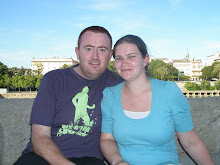Upon arrival in Sarajevo we caught a tram to Hostel City Centre, the location of which is self explanatory. Dropping off our bags, we set off for a walk in the Bascarsija (the Turkish district), which is full of little craft shops and cafes. The food in Bosnia and Hercegovina is awesome as well as really cheap – our three days in Sarajevo we lived on cevapcici (little sausages in pita bread) and bureks (pastries with fillings; our favs were potato and meat). The water is the freshest water I have ever tasted; it is so clear and drinkable that there are fountains around the city where you can stop and drink! We stopped for a drink (or two - of the alcoholic kind) at Cheers, the bar right next door to our hostel, which was to become a bit of a local while we were in town.
The following day we decided to do a walking tour to get ourselves better acquainted with this fascinating city. We discovered the sights and history of Sarajevo and its many churches and mosques - in Sarajevo, people of different religions lived in harmony for hundreds of years - and stopped at the place where the Austrian Archduke Franz Ferdinand was assassinated, setting in train a series of events leading to the outbreak of the First World War. In the afternoon it was time for some more exploring, eating, drinking and souvenir-buying. Bosnia is so cheap!
Next day we did the Sarajevo Tunnel Tour, which was amazing. It was run by a guy not much older than ourselves, early thirties. He was fifteen when the war broke out in 1992, and joined the Bosnian army the following year. Before war was over he was shot twice, on one occasion spending four months in hospital. He is now a doctor, having finished a medical degree after the war. He drove us to the Tunnel Museum out near Sarajevo airport in his jeep, pointing out stuff along the way, such as the Merkale Market where a grenade exploded, killing 16 and wounding 197 Sarajevo citizens. Our route took us along Sniper Alley, which is a stretch of road leading into town where Serb snipers had prime position to pick off people as they ran along it. Reaching the museum, we first watched a 15 minute film of the seige and the story of the tunnel. 25 metres or so of the original tunnel still exists as it was, which we were able to walk along. The tunnel was constructed as a way of getting food and supplies into the besieged city, with the entrance in the basement of a house near the airport and the exit in another house in free territory. Listening to this guy talk about the war and the siege of Sarajevo from first hand experience was amazing. We were only about 10 or 11 when this was going on - I don't think I even knew where Bosnia was. To be in Sarajevo and hear all this and see first hand where it happened just brings it all home, how terrifying and tragic it was. 90% of people killed were civilians, including about 1000 children. The scars in Sarajevo are still raw. Although many builings have been repaired, what is striking is the makeshift cemetaries which are dotted around the outskirts of town. Many of the famous Sarajevo roses in the town have been covered over, as the memories for many citizens are just too painful.
That afternoon, on returning to town, we went to Cheers with Josh, a guy from our hostel, to watch Manchester United wrap up the Premier League title. In the evening, the three of us thought we would go out to watch Sarajevo FC play. Thanks to the tourist booklet giving an incorrect start time, we arrived at the stadium for the final ten minutes (at least we didn't pay to get in). So we went back , had a last meal of cevapcici, and watched the Eurovision final instead.
After Sarajevo we caught a bus back into Croatia to Zagreb, where we spent a pleasant afternoon and evening (really cheap and lovely pasta meal) before a train to Budapest (same hostel as last time and the owner recognised Dave!) and a flight up to Norway. We are currently in Bergen and at the end of our trip. Stayed tuned!
Saturday, May 23, 2009
Subscribe to:
Post Comments (Atom)


No comments:
Post a Comment